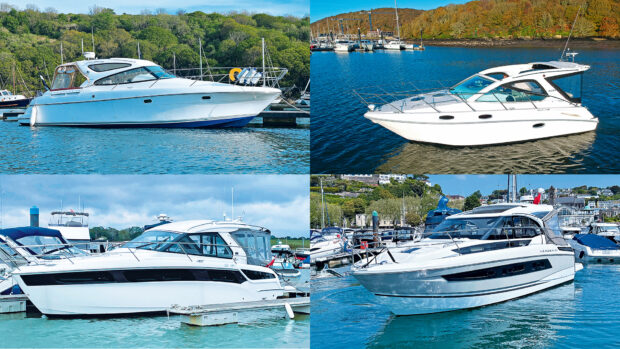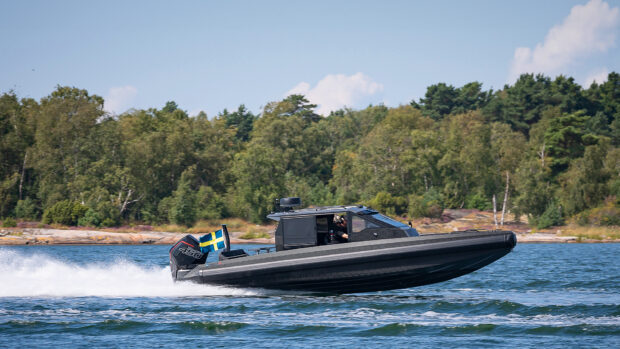Broom 37 owners, Kelston and Jackie Tobin, continue their leisurely circumnavigation of Britain from their winter base in Milford Haven to the Clyde via the Isle Of Man…
Regular readers may remember that last year we wrote about our spur-of-the-moment decision to extend our summer cruise from Kent to the Solent by simply carrying on cruising slowly round Britain in a clockwise direction.
By the end of the season we’d made it as far as South Wales so we arranged to leave our trusty Broom 37 Boisterous Mistress in Milford Marina for the winter. As we were many miles from home, it wasn’t until April that we managed to get back to our boat for the first time.
We wondered what state she would be in but she wasn’t actually too bad, just a bit green and covered in seagull poo and discarded mussel shells. After the usual wash, annual service, lift, antifoul and anode change, we decided to spend some time cruising the local area before continuing our progress north.
The whole point of our leisurely circumnavigation was to enjoy the places we visited, not just press on round for the sake of it. Over the next three months we managed to get to our boat every few weeks for 7-10 days at a time.
There are dozens of beautiful places to visit around Milford Haven estuary and the Cleddau river, even if the wind is blowing, so we’d venture out through the lock and either pick up a mooring buoy or put the anchor down for a night or two in one of the many sheltered spots.
Article continues below…

Broom 37 owners explain how they accidentally cruised from Kent to Wales

Broom 370 used boat review: Aft cabin cruiser is the Rolls-Royce of British boating
One particular highlight was a trip to Skomer island. It was bright and sunny as we ventured out into the Bristol Channel and enjoyed flat calm conditions on the 10-mile run to Skomer, squeezing through the narrow Jack Sound to get to the North Haven anchorage, where the island’s only landing stage is located.
The elusive puffins had not yet headed out to sea so we launched the dinghy and drifted among them surrounded by the sound of thousands of guillemots nesting on the rocks.
Lundy Island
We also wanted to visit Lundy Island, having missed it en route to Milford Haven from Padstow the previous year due to thick fog. Lundy is about 40 miles south of Milford Haven and the plan was to anchor off for a couple of days giving us time to explore.

A long-awaited visit to Lundy
The trip there and back would also be a good shakedown test prior to venturing north to Scotland.
Suitably provisioned, we left the marina and headed down Milford Haven. At the entrance I pushed the throttles open, adjusted the trim tabs and headed south into a noticeable Atlantic swell with a strengthening breeze whipping up white caps around us.
We trundled along at 18 knots but as the wind and waves were with us, it wasn’t too uncomfortable, just a bit like a long, slow roller coaster. However, as we went through the turbulent overfalls at the north of the island, I noticed a worrying vibration through the hull and a notable drop in speed.

Exploring the Milford Haven area before heading north
We initially put this down to the sea state and pressed on to the recommended anchorage but within 15 minutes we realised that it was far too uncomfortable to stay there and unanimously decided there was no alternative but to head back to the mainland.
Once past the overfalls I opened the throttles hoping to get onto the plane but it was obvious that we had a problem; as well as the ongoing vibration, the port engine temperature started to soar.
By sticking to 10 knots, we managed to keep the temperature down but it did mean a long, stressful, wet and bumpy four-hour ride back to the shelter of the estuary. It was with some relief that we dropped anchor off Dale just in time for the evening sun to make a welcome appearance.

Having a much-needed lift and service before cruising could commence
It wasn’t until a couple of days later that I managed to get out the diving gear and have a look under the boat. Sure enough there was a mass of rope wrapped around our port propeller. Luckily, there was just enough air in my diving bottle to go back down and cut the rope.
Now at last we were ready to press on north to Scotland.
Heading North
By mid-August there was talk of a period of settled weather coming in with a slow-moving high pressure system centred over the Irish Sea, so we headed back to Milford Haven in a one-way rental van.

The couple were fortunate to encounter Skomer’s puffins before they’d headed out to sea
By early afternoon we were back on board, giving us enough time to prepare for an early exit through the lock at 8am the following morning. As predicted it was another sunny day with a light easterly wind – perfect conditions for our first leg to Caernarfon, a distance of 120nm.
We had to be there by 5.30pm at the latest to ensure there was still enough water to gain access to the marina, so once we’d made it through Jack Sound, I opened the throttles and headed for Ramsey Sound.
Despite the favourable conditions, the sea was still quite lumpy, making us fearful of what the 60 miles across Cardigan Bay was going to be like. Thankfully, by the time we’d entered the sound separating Ramsey Island from St David’s Head, the sea had settled down considerably.

The rushing tide swirls around the Bitches of Ramsey
In fact as we approached the narrowest part where the Bitches rocks extend out from Ramsey Island, our speed over the ground gradually increased to 23 knots thanks to a helping hand from the quick tide which was swirling around the rocks on either side of us.
As we lost the shelter of St David’s Head and headed into Cardigan Bay, the wind stirred things up again, making the sea quite uncomfortable and creating lots of spray. Concerned that conditions might get progressively worse further out to sea, we headed north-east, hugging the coast directly into the wind and the waves.
We endured a rather wet, bumpy ride for about an hour passing Strumble Head and Fishguard but the further we went the smoother the conditions became.

Boisterous Mistress in prime position in Caernarfon marina
We could now head in the direction we wanted to go, and 40 miles later we were making our way through a very picturesque and calm Bardsey Sound (our Irish Sea Pilot book had mentioned huge standing waves here in adverse conditions) before heading along the coast towards Caernarfon Bay, 30 miles away.
The last 20 miles heading northeast along the coast was again wet and bumpy. As we were a bit later than planned we were now punching a fairly strong tide, which reduced our speed to 16 knots.
Using the chartlet that we had downloaded, we successfully identified the start of the channel across Caernarfon Bar. Thankfully we were still in time to access the marina.
Isle of Man
We had originally intended to stay for two nights but with the weather set fair we decided to push on north. The next morning was again warm and sunny with little wind, so we topped up with 360 litres of fuel and left at midday, giving us plenty of time to reach the fearsome Menai Strait at slack water.

Passing under the Menai Bridge after an uneventful passage through The Swellies
The mile-long passage through the Swellies wasn’t nearly as bad as we had been led to believe. Before long we were passing under the Menai bridge and heading along the buoyed channel, past Beaumaris and Bangor towards Puffin Island.
In glorious sunshine and oily smooth seas, we headed towards the Isle of Man, 52 miles away across the notoriously rough Irish Sea. It was so calm, we stayed at 8 knots, set the autopilot and enjoyed the ride. After leaving Puffin Island, we didn’t see another boat for hours but were thrilled to be visited by a pod of dolphins.
Finally, at about 7pm, we opened the throttles and sped the last 15 miles to Douglas at our usual 18 knots to avoid arriving in the dark.

Approaching the Isle of Man after a smooth crossing across the Irish Sea
At the time, the Isle of Man still had quite strict Covid regulations in place, so although we had been granted permission to enter we still had to clear immigration on arrival.
We were directed to the floating office where the ferries dock and, once the formalities had been completed, we moored up for the night on the visitor pontoon in the outer harbour as we weren’t permitted to enter the marina until the following morning.
Once safely inside, we turned our attention to refuelling. There is no manned fuel berth here, just a self-service pump operated by Manx Fisheries. I called the head office and arranged to buy a pre-paid card for 300 litres of diesel, which would have to be collected from their office in Peel on the west of the island.

Strict Covid regulations meant the couple had to clear immigration in Douglas
Our original plan was to hire a car to explore the island and collect our fuel card en route, but as no cars were available we had to take the bus.
Fuel crisis
Peel was cold and worryingly windy but had a fascinating museum full of historic TT motorcycles and memorabilia. We enjoyed a hearty lunch of Manx kippers at the Creek Inn then got back on the bus heading north to Ramsey.
After a brief look around the town and along the beach we caught the last train back to Douglas on the historic Manx electric railway. The 90-minute journey along the hilly east coast was really enjoyable and a fitting end to our visit.

Rough seas were predicted between the IOM and the Mull of Galloway
Despite a less than ideal Force 3 to 4 coming from the north east, we left Douglas marina on the first bridge lift at 7.45am and headed to the fuel berth near the harbour entrance. Once secured, I clambered up the 20ft steel ladder to the fuel pump, armed with our pre-loaded fuel card and four-digit pin.
The instructions said that I had just 45 seconds after entering the pin number to remove the nozzle, lower it down the 20ft drop to Jackie and pull the trigger before the system would shut down again, making the whole process rather stressful but we managed to get 150 litres in one side, then had to start the entire process again for the second tank.
To make matters worse, Port Control told us to leave ASAP as the morning ferry was ready to depart. We did as instructed but left in a bit of a rush with our fenders still out and ropes not put away.

We weren’t prepared for the sea that greeted us as we left the harbour. It was about as rough as we could take and straight on the nose. We eventually managed to secure everything and started the long slog up the east coast, bracing ourselves for an unpleasant hour and a half.
It was every bit as bad as expected, and I had to make full use of the wheel and throttles to pick our way through the waves and dodge the overfalls created by the sand banks and shallow water. It was a massive relief when we finally reached the north of the island and could switch our focus to reaching Scotland, some 25 miles away.
Now heading north west, we had the sea on our starboard beam so it was time to open the throttles and enjoy another roller-coaster ride. Our speed ranged between 18 to 22 knots and the exhausts roared as we rolled violently from side to side, but we needn’t have feared as our trusty Broom took the conditions in her stride.

We approached the Mull of Galloway with some trepidation as the charts showed violent overfalls. However we were relieved to find it became smoother the closer we got to the land and we were soon eating up the final 15 miles to Portpatrick on a calm and very flat sea.
With another 60 miles under our belts, we entered the narrow channel and managed to find a cosy corner berth alongside the harbour wall.
Having taken a wander around town we headed to the Crown Inn where we sat outside in the sunshine enjoying some lovely food before retiring to Boisterous Mistress for a glass or two of wine as we watched the fishing boats unload their catches.

Portpatrick’s idyllic harbour and town charmed Jackie and Kelston
We were tempted to stay another night but we were aware that the settled weather conditions were about to change. We left Portpatrick at 10.45am the next morning. It was flat calm to start with but became increasingly uncomfortable as we got nearer the Firth of Clyde.
For the next 30 miles we battled through a constant barrage of spray as we headed straight into the wind and waves along a rocky coastline made even more hostile by grey, foreboding skies. Gradually, the conditions improved until eventually the sun popped out for the last 25 miles to Prestwick.
We were even welcomed into the Clyde estuary by a pod of friendly porpoises. When we entered Kip Marina at 3pm our fuel gauges were close to empty.

At last the couple could hoist a Scottish courtesy flag
New Scottish base
Having moored up and checked in with the helpful marina staff, we went in search of the local supermarket for some provisions and then checked out one of the bars at the Inverkip Hotel.
This was to be our new winter berth and from what we’d seen of it we were impressed. We now had three days to pack the boat away before heading home.
The first was spent cleaning her inside and out before brimming the tanks for winter. On the second we took the train to Edinburgh to see the sights and collect a car that I had bought as our transport home. On the last day the weather was so nice that we took the boat out for one final trip over to Bute.

Celebrating the end of their 321-mile journey with a magical trip to Bute
It was a glorious day and we trundled along at 7 knots in the sunshine, seeing more porpoises and a seal as well as the famous paddle steamer, Waverley.
It was a fitting end to our 321 miles cruise from Milford Haven. Our boat had done us proud yet again – requiring nothing more than a splash of oil and a fair bit of diesel to keep on trucking.
We now plan to remain in Inverkip for the 2022 season and use it as a base to explore the Western Isles before once again continuing our slow journey round Britain.
First published in the June 2022 issue of MBY.

Anchored in Watwick Bay, near Milford Haven

Dinner on deck in Milford Haven

Approaching Barsey Sound

Irish Sea Dolphins

All moored in Scotland after a 321-mile trip











